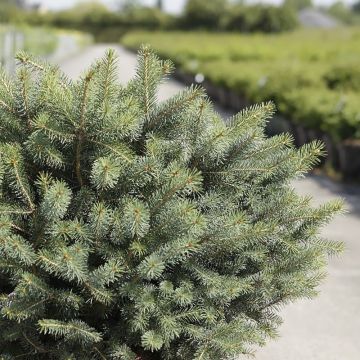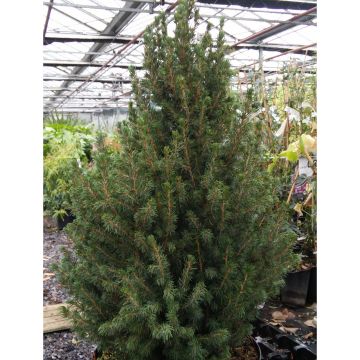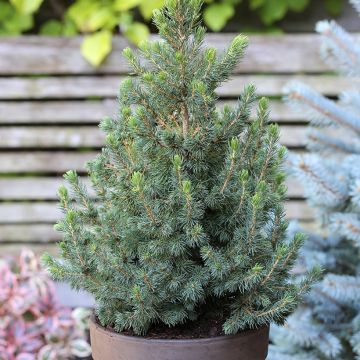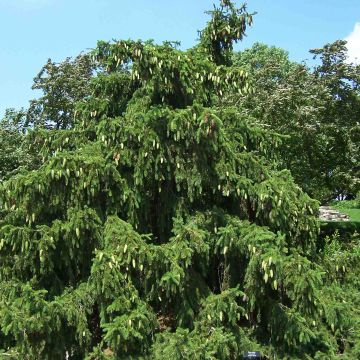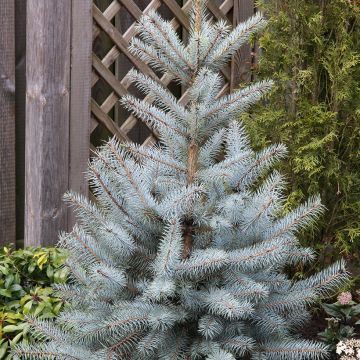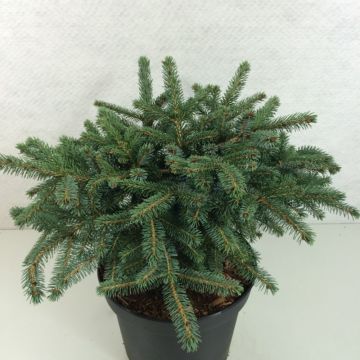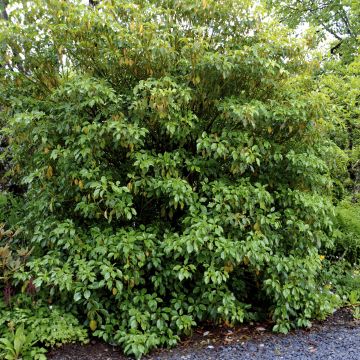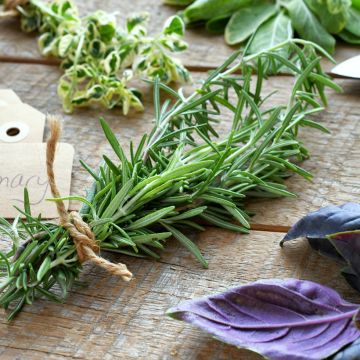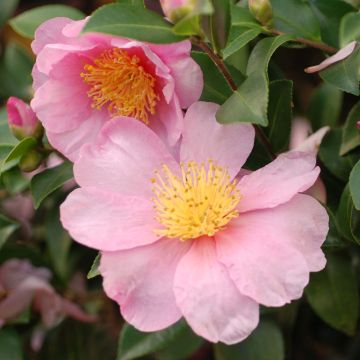

Picea omorika Alexandra - Serbian spruce
Picea omorika Alexandra - Serbian spruce
Picea omorika Alexandra
Serbian Spruce, Balkan Spruce
Why not try an alternative variety in stock?
View all →This plant carries a 24 months recovery warranty
More information
We guarantee the quality of our plants for a full growing cycle, and will replace at our expense any plant that fails to recover under normal climatic and planting conditions.
From €5.90 for pickup delivery and €6.90 for home delivery
Express home delivery from €8.90.
Does this plant fit my garden?
Set up your Plantfit profile →
Description
Picea omorika 'Alexandra' is a dwarf variety of Serbian Spruce. It has a very slow growth, forming a small, dense and regular bush with a conical habit. Its thin, yellow branches are horizontal to slightly pendulous and bear short, green-grey needles. The new shoots have a bluish tint. Plant it in a small garden, a large rockery or a flower bed. Its charming appearance, resembling a simplified Christmas tree, is very dense. It is very hardy and not demanding in cool climates, preferring well-drained soils that are not too dry and a sunny exposure.
Picea omorika, also known as Serbian Spruce, is a plant of the pinaceae family, native to Bosnia and Serbia. It is a rare species endemic to the Drina Valley (in western and eastern Serbia), although it can also be found in Bosnia and Herzegovina. In its natural environment, which is often harsh, this tree can reach a height of over 30 m and has a narrow pyramidal shape and pendulous branches. This conifer is very tolerant of soil conditions and resistant to pollution.
The 'Alexandra' variety is a small conifer with a compact and conical habit, forming a triangular or pyramidal bush after many years. It has a slow growth and reaches a height of 1 m to 1.20 m in 10 years. It produces thin and flexible branches covered with short needles, measuring 10 to 20 mm in length. The grey-green needles are flat, soft to the touch, arranged in dense and aromatic brushes, emitting a resinous smell.
The dwarf Serbian Spruce 'Alexandra', which is relatively easy to grow, adapts to many climates, as long as the soil is well-drained. It has an endearing silhouette and a solid and structuring presence. Its compact size allows it to be planted in gardens of all sizes. In smaller gardens, it can serve as a tree, just like in a small flower bed or rockery scene. Pair it with other dwarf conifers with different foliage colours, such as steel blue or yellow-green, developing other shapes, such as trailing, globose, or columnar. Evergreen conifers have interesting architectural qualities for all gardens, especially contemporary gardens that are more radical in their choice of shape and foliage. Play with volumes and colours by combining them with flowering shrubs and ground cover plants.
Report an error about the product description
Plant habit
Foliage
Botanical data
Picea
omorika
Alexandra
Pinaceae
Serbian Spruce, Balkan Spruce
Cultivar or hybrid
Other Picea
Planting and care
Picea omorika 'Alexandra' should be planted from September to November and from February to June in ordinary, well-drained soil, not too dry but rather fertile. A sandy, humus-bearing or rocky soil will be perfectly suitable. Choose a sunny or semi-shaded location, sheltered from prevailing winds. It will not thrive in overly sunny and dry, or too hot and humid conditions. Soak the root balls well before planting. Add organic fertiliser at planting and water generously in the first few years, and during prolonged drought. Apply a special conifer fertiliser every year in April and cultivate the soil in summer. This very hardy conifer (to -30°C at least) is still sensitive to heavy soils that become waterlogged in winter. Pruning is usually not necessary. If unruly branches appear, they should be removed to maintain the desired shape and allow the plant to reach its full potential.
Planting period
Intended location
Care
This item has not been reviewed yet - be the first to leave a review about it.
Evergreen shrubs
Haven't found what you were looking for?
Hardiness is the lowest winter temperature a plant can endure without suffering serious damage or even dying. However, hardiness is affected by location (a sheltered area, such as a patio), protection (winter cover) and soil type (hardiness is improved by well-drained soil).

Photo Sharing Terms & Conditions
In order to encourage gardeners to interact and share their experiences, Promesse de fleurs offers various media enabling content to be uploaded onto its Site - in particular via the ‘Photo sharing’ module.
The User agrees to refrain from:
- Posting any content that is illegal, prejudicial, insulting, racist, inciteful to hatred, revisionist, contrary to public decency, that infringes on privacy or on the privacy rights of third parties, in particular the publicity rights of persons and goods, intellectual property rights, or the right to privacy.
- Submitting content on behalf of a third party;
- Impersonate the identity of a third party and/or publish any personal information about a third party;
In general, the User undertakes to refrain from any unethical behaviour.
All Content (in particular text, comments, files, images, photos, videos, creative works, etc.), which may be subject to property or intellectual property rights, image or other private rights, shall remain the property of the User, subject to the limited rights granted by the terms of the licence granted by Promesse de fleurs as stated below. Users are at liberty to publish or not to publish such Content on the Site, notably via the ‘Photo Sharing’ facility, and accept that this Content shall be made public and freely accessible, notably on the Internet.
Users further acknowledge, undertake to have ,and guarantee that they hold all necessary rights and permissions to publish such material on the Site, in particular with regard to the legislation in force pertaining to any privacy, property, intellectual property, image, or contractual rights, or rights of any other nature. By publishing such Content on the Site, Users acknowledge accepting full liability as publishers of the Content within the meaning of the law, and grant Promesse de fleurs, free of charge, an inclusive, worldwide licence for the said Content for the entire duration of its publication, including all reproduction, representation, up/downloading, displaying, performing, transmission, and storage rights.
Users also grant permission for their name to be linked to the Content and accept that this link may not always be made available.
By engaging in posting material, Users consent to their Content becoming automatically accessible on the Internet, in particular on other sites and/or blogs and/or web pages of the Promesse de fleurs site, including in particular social pages and the Promesse de fleurs catalogue.
Users may secure the removal of entrusted content free of charge by issuing a simple request via our contact form.
The flowering period indicated on our website applies to countries and regions located in USDA zone 8 (France, the United Kingdom, Ireland, the Netherlands, etc.)
It will vary according to where you live:
- In zones 9 to 10 (Italy, Spain, Greece, etc.), flowering will occur about 2 to 4 weeks earlier.
- In zones 6 to 7 (Germany, Poland, Slovenia, and lower mountainous regions), flowering will be delayed by 2 to 3 weeks.
- In zone 5 (Central Europe, Scandinavia), blooming will be delayed by 3 to 5 weeks.
In temperate climates, pruning of spring-flowering shrubs (forsythia, spireas, etc.) should be done just after flowering.
Pruning of summer-flowering shrubs (Indian Lilac, Perovskia, etc.) can be done in winter or spring.
In cold regions as well as with frost-sensitive plants, avoid pruning too early when severe frosts may still occur.
The planting period indicated on our website applies to countries and regions located in USDA zone 8 (France, United Kingdom, Ireland, Netherlands).
It will vary according to where you live:
- In Mediterranean zones (Marseille, Madrid, Milan, etc.), autumn and winter are the best planting periods.
- In continental zones (Strasbourg, Munich, Vienna, etc.), delay planting by 2 to 3 weeks in spring and bring it forward by 2 to 4 weeks in autumn.
- In mountainous regions (the Alps, Pyrenees, Carpathians, etc.), it is best to plant in late spring (May-June) or late summer (August-September).
The harvesting period indicated on our website applies to countries and regions in USDA zone 8 (France, England, Ireland, the Netherlands).
In colder areas (Scandinavia, Poland, Austria...) fruit and vegetable harvests are likely to be delayed by 3-4 weeks.
In warmer areas (Italy, Spain, Greece, etc.), harvesting will probably take place earlier, depending on weather conditions.
The sowing periods indicated on our website apply to countries and regions within USDA Zone 8 (France, UK, Ireland, Netherlands).
In colder areas (Scandinavia, Poland, Austria...), delay any outdoor sowing by 3-4 weeks, or sow under glass.
In warmer climes (Italy, Spain, Greece, etc.), bring outdoor sowing forward by a few weeks.












































